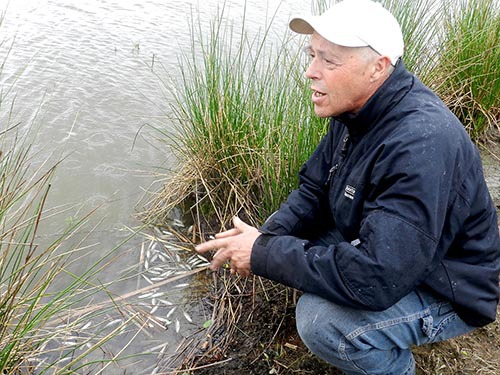
Gary Stewart at Willband Creek Park on May 13, the day after he discovered thousands of dead fish in a retention pond.
The Ministry of Environment (MoE) has concluded its investigation into the deaths of thousands of small fish in a large detention pond in Willband Creek Park in Abbotsford, and the incident remains a mystery.
MoE spokesman David Karn said an emergency response officer tested the water temperature, pH levels, conductivity and dissolved oxygen, and
determined none of those were connected to the deaths.
Contamination of the water was also ruled out."There was no obvious source of contamination and no physical sign that the fish were exposed to a chemical contaminant," Karn said.
The city's environmental team was also notified. Rhonda Livingstone, spokesperson for the City of Abbotsford, said the fish kill is being considered an "unfortunate mystery."
"City staff will be closely monitoring the ponds to see if any new issues crop up, but the hope is that we won't have any similar incidents and we can chalk this up to a one-time, unusual event," she said.
The dead fish were discovered on Sunday, May 12 by Abbotsford resident Gary Stewart while he was out for a walk.
Stewart immediately informed the ministry, which sent out an environmental emergency response officer that afternoon.
Volunteers with the Ravine Park Salmon Enhancement Society were also notified, and they determined that the fish were three-spined stickleback. No other fish appeared to have been impacted.
Doug Gosling, a member of the Stoney Creek Salmon Stalkers, which is affiliated with RPSES, said he is disappointed that the MoE is not investigating the incident further.
"Thousands of fish showing up on the shores of one of our local waterways seems to me to be important enough to garner a fairly significant investigation ... by doing nothing much more than a little snoop-around and shrugging our shoulders won't help in preventing another similar event."
He said the MoE should be pushed to provide answers.
"I think they need to know there are lots of people interested in this event and something needs to be done to prevent it happening again."
Willband Creek Park is located in east Abbotsford at Highway 11 and Bateman Road.

Comment: Although 'falls' of migrating birds in most years are not that unusual, what marks out this Spring season in particular is the late occurrence and numbers involved across both North America and Eurasia due to late cold weather. Many have been reported dead or dying.
See a sample of these other reports for instance -
Many bluebirds couldn't survive this cold spring in Loveland, Colorado
Prolonged winter weather grounds birds in Northland, Minnesota
Over 100 dead birds found in Danville & Pittsylvania County, Virginia
Hundreds of birds die of starvation after spring snowstorm in Colorado
Bird jams: Long winter sends migratory flocks into tailspin in Germany
Rare birds killed off after migration north sees them face freezing temperatures back in UK
In Belarus, for returning storks, blackbirds, swallows the prolonged winter is a disaster
Wacky weather producing one of Alaska Interior's craziest spring migrations on record
Warbler 'fallout' on Park Point, Dulth amazes birders